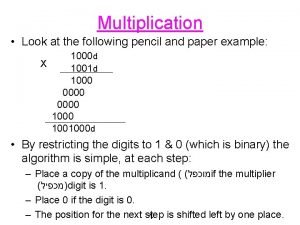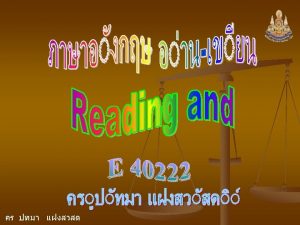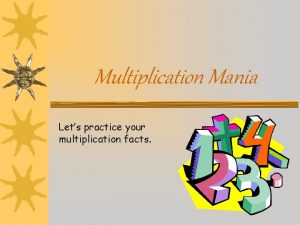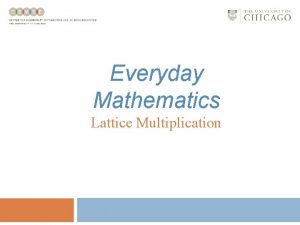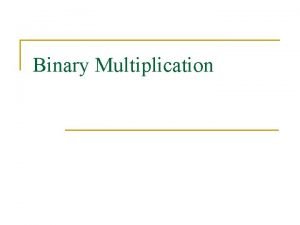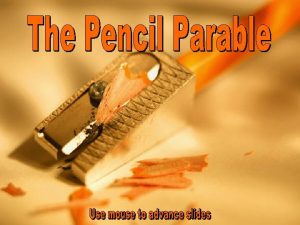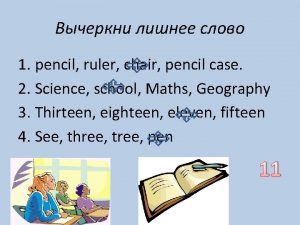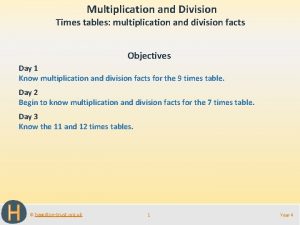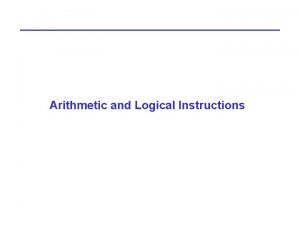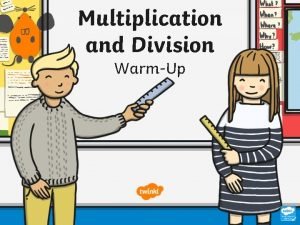Multiplication Look at the following pencil and paper























- Slides: 23

Multiplication • Look at the following pencil and paper example: 1000 d X 1001 d 1000 0000 1001000 d • By restricting the digits to 1 & 0 (which is binary) the algorithm is simple, at each step: – Place a copy of the multiplicand ( ( מוכפל if the multiplier ( )מכפיל digit is 1. – Place 0 if the digit is 0. – The position for the next step is shifted left by one place. 1

First Multiplication Algorithm • Half of the multiplicand bits are always zero. So using a 64 -bit ALU is useless and slow. • What would happen if we added the multiplicand to the left half of the product and 2 shift right?

Second Multiplication Algorithm • There still is waste, the product has wasted space that matches the multiplier exactly. • As the wasted space in the product disappears, so do bits in the multiplier. • The multiplier can now be in 3 the lower half of the product.

Final Multiplication Algorithm • This algorithm can properly multiply signed numbers if we remember that the numbers have infinite digits. • When shifting right we must extended the sign. This is called an arithmetic shift. 4

Division • Look at the following pencil and paper example: 1001 d 1000 d 1001010 d -1000 10 1010 -1000 10 d • The 2 operands are called dividend ( ( מחולק and divisor ( ( מחלק and the results are the quotient ( ( מנה and remainder (( שארית 5

First Division Algorithm 6 • The Remainder is initialized with the dividend. • The divisor is in the left half of the Divisor. • As with multiplication, only half of the Divisor is useful, a 64 -bit register and ALU are wasteful.

Second Division Algorithm • Shift the remainder left by 1 bit. • Subtract the divisor from the remainder. • If the remainder is positive the quotient bit is 1, if negative the quotient bit is 0 and the divisor added back to the remainder. • At termination of the algorithm the remainder is in the left half of the Remainder register. • As in multiplication the Quotient register can be eliminated by holding the quotient in the bits vacated in the Remainder. 7

Final Division Algorithm • The remainder will be shifted left once to many times. Thus the reminder must be shifted right 1 -bit at the end of the algorithm. 8

A Division Example • We will divide 2 4 -bit numbers using the final division algorithm - 0111/0010 (7/2) • Itr Step 0 Initial values Shift Rem left 1 1 2: Rem=Rem-Div 3 b: Rem<0 => +Div, sll R, R 0=0 2 2: Rem=Rem-Div 3 b: Rem<0 => +Div, sll R, R 0=0 3 2: Rem=Rem-Div 3 a: Rem>=0 => sll R, R 0=1 4 2: Rem=Rem-Div 3 a: Rem>=0 => sll R, R 0=1 Shift left half of Rem right by 1 9 Remainder 0000 0111 0000 1110 0001 1100 1111 1100 0011 1000 0001 1000 0011 0001 0010 0011 0001 0011 Divisor 0010 0010 0010

Signed Division • One solution is to remember the signs of the divisor and dividend and negate the quotient if the signs disagree. • But there is a complication with the remainder: Dividend = Quotient*Divisor + Remainder = Dividend - Quotient*Divisor • Lets look at all the cases of 7/2: 7/2 -7/2 7/-2 -7/-2 Quotient= 3 Quotient=-3 Quotient= 3 Remainder = 7 - (3*2) = 1 Remainder = -7 - (-3*2) = -1 Remainder = 7 - (-3*-2) = 1 Remainder = -7 - (3*-2) = -1 • The quotient is negated if the signs oppose and the remainder is the same sign as the dividend. 10

Multiplication in MIPS • MIPS provides a pair of 32 -bit registers to contain the 64 -bit product, called Hi and Lo. MIPS has 2 instructions for multiplication: mult $s 2, $s 3 # Hi, Lo = $s 2*$s 3 (signed) multu $s 2, $s 3 # Hi, Lo = $s 2*$s 3 (unsigned) • MIPS ignores overflow in multiplication. • The instructions: mflo $t 0, mfhi $t 0, mtlo $t 0, mthi $t 0 move from/to Lo and Hi to general registers. • The pseudoinstructions: mul $t 0, $s 1, $s 2 #$t 0=$s 0*$s 1 (without overflow) mulo $t 0, $s 1, $s 2 # $t 0=$s 0*$s 1 (with overflow) mulou $t 0, $s 1, $s 2 # $t 0=$s 0*$s 1 (unsigned with overflow) Perform multiplication and put the product in the specified 11 general register.

Division in MIPS • MIPS has 2 instructions for division: div $s 2, $s 3 # Hi=$s 2%$s 3, Lo=$s 2/$s 3 (signed) divu $s 2, $s 3 # Hi=$s 2%$s 3, Lo=$s 2/$s 3 (unsigned) • MIPS ignores overflow in division. • The pseudoinstructions: div $t 0, $s 1, $s 2 #$t 0=$s 0/$s 1 (signed) divu $t 0, $s 1, $s 2 # $t 0=$s 0/$s 1 (unsigned) Perform division and put the quotient in the specified general register. • The pseudoinstructions: rem $t 0, $s 1, $s 2 #$t 0=$s 0%$s 1 (signed) remuu $t 0, $s 1, $s 2 # $t 0=$s 0%$s 1 (unsigned) Perform division and put the remainder in the specified general register. 12

Floating-Point Numbers • The following numbers can't be represented in an integer (signed or unsigned): 3. 14159265… (p) , 2. 71828… (e), 0. 00001 or 1. 0*10 -9 (seconds in a nanosecond), 6, 311, 520, 000 or 6. 31152*109 (seconds in two centuries). • The notation where there is only one number to the left of the decimal point is called scientific notation. A number in scientific notation which has no leading zeros is called a normalized number. • A binary floating point number is of the form: 1. xxx*2 yyy , the number 9 d or 1001 is represented as: 1. 001*211(3 d) , 2. 5 d or 10. 1 b is: 1. 01*21 13

Floating-Point Representation • A floating-point number in MIPS is a 32 -bit value that contains 3 fields: The sign (1 -bit), the exponent (8 -bit) and the mantissa or significand (32 -bit). These 3 fields compose a binary FP number: (-1)sign*mantissa*2 exponent • s exponent mantissa 31 30 …………… 23 22 ………………. . . ………………. 0 • This representation is called sign and magnitude because the sign has a separate bit. • The range of a float is between fractions as small as 2*10 -38 to numbers as large as 2*1038. • It is still possible to overflow a float (the exponent is too large), in fact now we can also cause an underflow (the exponent is too small). 14

Enlarging the Range and Precision • Even though the range is large it isn't infinite. In order to enlarge this range two MIPS words are used, this is called a double precision FP number. Single precision is the name of the previous format. • A double has the same 3 fields of a float: sign (1 -bit), exponent (11 -bits), and mantissa (52 -bits). • In order to pack more bits into the mantissa the leading 1 to the left of the binary point is implicit. Thus a binary FP number is: (-1)sign*(1 + mantissa)*2 exponent • This representation isn't unique to MIPS. It is part of the IEEE 754 floating-point standard. • The designers of IEEE 754 want a representation that could be easily processed by integer comparisons. That is why the sign is the MSB and the exponent is right after it. 15

Biased Notation • Negative exponents can cause problems, a negative exponent in two's complement looks like a large exponent. Thus we will represent the most negative exponent as 00… 00 b and the most positive exponent as 11… 11 b. • This convention is call biased notation with the bias being the number subtracted from the normal, unsigned representation. IEEE 754 uses a bias of 127 for single precision. So an exponent of -1 is represented by -1 + 127, or 126 d = 0111 1110 b. An exponent of 10 is represented by 10+127=137 d=10001001. • Now the value represented by a FP number is really: (-1)sign*(1 + mantissa)*2(exponent-bias) • The bias of a double precision number is 1023. 16

Decimal to FP Representation • Show the IEEE 754 rep. of the number -0. 75 in single and double precision. -0. 75= -0. 5 + -0. 25 = -0. 1 b + -0. 01 b = -0. 11*20 (scientific notation) = -1. 1*2 -1 (normalized scientific notation) So in a FP representation it is: (-1)sign*(1 + mantissa)*2(exponent-bias) => (-1)1*(1 +. 1)*2(126 -127) • The single precision representation is: 1 01111110 100000000000 sign exponent (8 -bits) mantissa (23 -bits) • The double precision representation is: 1 0111110 10000000000000000. . . sign exponent (11 -bits) mantissa (52 -bits) this is because the double precision representation is: (-1)1*(1 +. 1)*2(1022 -1023) 17

Binary to Decimal FP • What decimal number is represented by: 1 1000001 0100000… (single precision) (-1)sign*(1 + mantissa)*2(exponent-bias) => (-1)1*(1 +. 25)*2(129 -127) = -1. 25*22 = -1. 25*4 = -5. 0 • What decimal number is represented by: 0 1000010 101100… (double precision) (-1)0*(1 +. 5 +. 125 +. 0625)*2(1026 -1023) = 1. 6875*23 = 1. 6875*8 = 13. 5 • Let's double check to make sure: 13. 5 d = 1101. 1 b = 1. 1011*23 The sign bit is 0, exponent - bias = 3 => exponent = 1026 d = 1000010 b, and the mantissa without the leading 1 is 1011…. . . 18

Floating-Point Addition • Let's add 2 normalized decimal FP numbers 9. 999*101 + 1. 610*10 -1 (the maximal precision is 4 digits) • In order to add correctly we must align the decimal points of both numbers by shifting the mantissa of the smaller number right until the exponents match: 9. 999*101 + 0. 016*101 10. 015*101 • The sum isn't normalized so we have to shift the result (right in this example). 10. 015*101 = 1. 0015*102 • But the sum is represented by 5 digits so we must round the sum to 1. 002* 102 • We see here two problems that cause precision loss, the 19 final rounding. matching of exponents and the

Binary FP Addition Diagram of a FP adder 20

FP Multiplication • The idea is simple: Add the exponents and multiply the mantissas. Set the sign depending on the signs of the operands. • Division is similar: Subtract the exponents and divide the mantissas. 21

FP Instructions in MIPS • MIPS has a set of 32, single precision, FP registers called $f 0, $f 1 … $f 31. Double precision instructions use two such registers, using the even numbered register as it's name. • MIPS provides the following FP instructions: – Addition: single add. s $f 1, $f 2, $f 3# $f 1=$f 2+$f 3 double add. d $f 0, $f 2, $f 16#$f 0=$f 2+$f 16 – Subtraction: sub. s, sub. d – Multiplication & Division: mul. s, mul. d, div. s, div. d – Branch: branch if true, bc 1 t; branch if false, bc 1 f. True or false are set by the following comparison instructions: – Comparision: • equal - c. eq. s, c. eq. d • less then - c. lt. s, c. lt. d • less then or equal - c. le. s, c. le. d 22

Compiling a FP Program into MIPS • Let's convert a temperature in Fahrenheit to Celsius: float f 2 c (float fahr) { return((5. 0/9. 0) * (fahr -32. 0)); } • In MIPS assembly (the first 2 instructions load from memory into FP registers, fahr is in $f 12): f 2 c: lwc 1 $f 16, const 5($gp) # $f 16=5. 0 (5. 0 in memory) lwc 1 $f 18, const 9($gp) # $f 18=9. 0 (9. 0 in memory) div. s $f 16, $f 18 # $f 16=5. 0/9. 0 Many compilers would divide 5. 0/9. 0 at compile time and store the result in memory, saving a divide and load lwc 1 $f 18, const 32($gp)# $f 18=32. 0 sub. s $f 18, $f 12, $f 18 # $f 18=fahr-32. 0 mul. s $f 0, $f 16, $f 18 # $f 0=(5. 0/9. 0)*(fahr-32. 0) jr $ra 23# return
 Look left right
Look left right Paper and pencil algorithm multiplication
Paper and pencil algorithm multiplication Paper and pencil honesty test
Paper and pencil honesty test Duotangs,paper,pencil,eraser,calculator,pens,highlighter
Duotangs,paper,pencil,eraser,calculator,pens,highlighter Activity 4 look at the pictures
Activity 4 look at the pictures Activity 4 look for it
Activity 4 look for it Look at the picture in activity 3
Look at the picture in activity 3 Aice english paper 2
Aice english paper 2 Aice general paper
Aice general paper Take a look at these pictures
Take a look at these pictures Look at the picture and answer the questions below
Look at the picture and answer the questions below Take look at the following pictures and answer
Take look at the following pictures and answer Look at the following pictures
Look at the following pictures Look at the picture and answer the question
Look at the picture and answer the question Hình ảnh bộ gõ cơ thể búng tay
Hình ảnh bộ gõ cơ thể búng tay Lp html
Lp html Bổ thể
Bổ thể Tỉ lệ cơ thể trẻ em
Tỉ lệ cơ thể trẻ em Chó sói
Chó sói Chụp tư thế worms-breton
Chụp tư thế worms-breton Chúa yêu trần thế
Chúa yêu trần thế Môn thể thao bắt đầu bằng chữ f
Môn thể thao bắt đầu bằng chữ f Thế nào là hệ số cao nhất
Thế nào là hệ số cao nhất Các châu lục và đại dương trên thế giới
Các châu lục và đại dương trên thế giới

